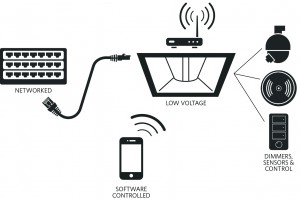This article is shared from Electronics Weekly
LED lighting promises lower costs because it delivers a longer operational life and higher energy savings compared to alternative lighting options. When it is connected to the network, such as through a wireless or power-over-Ethernet (PoE) connection, users also gain unprecedented control, through automated and remote access, to dynamically adjust the brightness, on-off patterns, and/or colour of each IP-addressable lamp.
The internet of things (IoT) also promises lower costs by integrating sensors with devices so that network systems can automatically detect and shut down devices when they are not being used. Because devices are connected to the network, users with the right software and security access can remotely monitor  and command them.
and command them.
 and command them.
and command them.
The lessons of history
Both LED lighting and IoT device technologies are in the early-adopter phase of their respective lifecycles. The technologies underlying them are relatively mature, but neither has yet experienced an explosion in demand with a must-purchase product. So how can these technologies reach the tipping point that leads to general adoption? The history of such transitions in other products can give some indication.
Desktop computing reached its tipping point after operating systems supported a graphical user interface and hid from the user much of the complexity of connecting computers and peripheral resources.
Digital video recorders led the transition away from video tape by moving the tiny control panel display on to the larger television display and connecting to the content of provider’s servers, allowing users to specify what they wanted to record by the name of the show rather than by date and time.
Smartphones and tablets reached their tipping point after multi-touch user interface displays simplified how users issued commands, which also made it easier to connect devices to other services.
In each case the new feature of the user interface made the device easier to use and easier to connect with other resources and services. This expanded the capability of the original device.
What about the future?
Is the ability to monitor and control lighting and IoT devices with your smartphone sufficient to push connected LEDs into general adoption? What would be the impact if we explicitly connect and integrate IoT devices with the locally networked LED lighting system? Connecting IoT devices to IP-addressable LED lighting can provide a novel way to deliver new capabilities to users.
Is the ability to monitor and control lighting and IoT devices with your smartphone sufficient to push connected LEDs into general adoption? What would be the impact if we explicitly connect and integrate IoT devices with the locally networked LED lighting system? Connecting IoT devices to IP-addressable LED lighting can provide a novel way to deliver new capabilities to users.
Hearing loss is a relatively common physical condition, so connecting alarms, doorbells, baby monitors, smoke detectors, and door locks to the LED lighting network has real benefits. This enables the system to use colour changes and flashing lights to notify users when an alarm goes off, when something in the kitchen needs attention, when there is someone at the door, and even when and in which direction there is an emergency.
For people with reduced hearing who already use similar systems, the lighting system is special-purpose and hardwired. A networked LED lighting system can provide this capability and follow the user to whichever room they may be in at no additional cost other than acquiring the right software.
When all of the lamps in an LED lighting system are considered as a whole, even more impressive capabilities become possible. Imagine you are in a public building for the first time and an emergency such as a fire occurs that takes out the building’s power. How would you find the quickest and safest way out of the building? LED lighting systems connected via PoE can still operate in a power outage if the network has battery backup.
If environmental sensors were connected to the LED lighting system, lamps could be used in conjunction with one another, changing their colours and their on-off state to direct occupants to safe exits. If a path became unsafe, the lighting system could reroute occupants.
Until now, the most important driver for lighting has been to improve energy efficiency and reduce cost. Connecting IoT devices and sensors with a lighting system increases opportunities to provide new capabilities with a simple user interface. Because all LED lamps and IoT devices are individually IP-addressable, they can each give a personalised response.
Because many new capabilities arise from using existing devices in combination with each other, installing LED lighting and IoT devices can future-proof them, so that other new capabilities need only be software changes. It is likely that the transition to a general adoption of these two technologies is intimately intertwined.
For complete and original post see here



